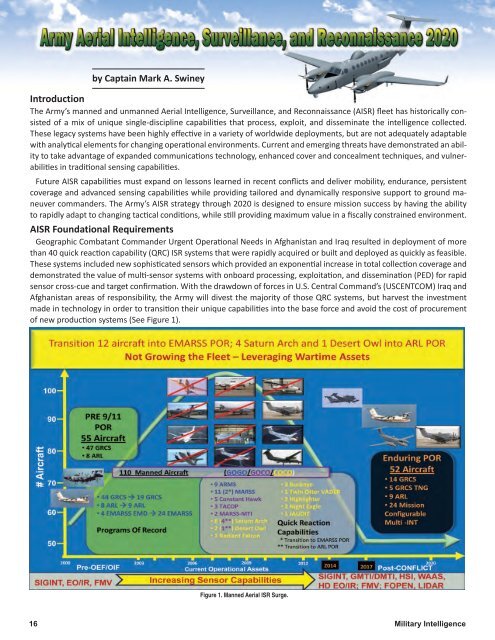2014_01
2014_01
2014_01
You also want an ePaper? Increase the reach of your titles
YUMPU automatically turns print PDFs into web optimized ePapers that Google loves.
y Captain Mark A. SwineyIntroductionThe Army’s manned and unmanned Aerial Intelligence, Surveillance, and Reconnaissance (AISR) fleet has historically consistedof a mix of unique single-discipline capabilities that process, exploit, and disseminate the intelligence collected.These legacy systems have been highly effective in a variety of worldwide deployments, but are not adequately adaptablewith analytical elements for changing operational environments. Current and emerging threats have demonstrated an abilityto take advantage of expanded communications technology, enhanced cover and concealment techniques, and vulnerabilitiesin traditional sensing capabilities.Future AISR capabilities must expand on lessons learned in recent conflicts and deliver mobility, endurance, persistentcoverage and advanced sensing capabilities while providing tailored and dynamically responsive support to ground maneuvercommanders. The Army’s AISR strategy through 2020 is designed to ensure mission success by having the abilityto rapidly adapt to changing tactical conditions, while still providing maximum value in a fiscally constrained environment.AISR Foundational RequirementsGeographic Combatant Commander Urgent Operational Needs in Afghanistan and Iraq resulted in deployment of morethan 40 quick reaction capability (QRC) ISR systems that were rapidly acquired or built and deployed as quickly as feasible.These systems included new sophisticated sensors which provided an exponential increase in total collection coverage anddemonstrated the value of multi-sensor systems with onboard processing, exploitation, and dissemination (PED) for rapidsensor cross-cue and target confirmation. With the drawdown of forces in U.S. Central Command’s (USCENTCOM) Iraq andAfghanistan areas of responsibility, the Army will divest the majority of those QRC systems, but harvest the investmentmade in technology in order to transition their unique capabilities into the base force and avoid the cost of procurementof new production systems (See Figure 1).Figure 1. Manned Aerial ISR Surge.16 Military Intelligence


